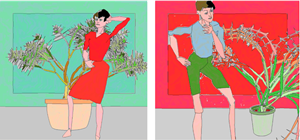
Harold Cohen: AARON, opening at the Whitney Museum of American Art on February 3, 2024, examines the evolution of AARON, the first AI artmaking program, which was developed in the late 1960s by artist Harold Cohen.
Beginning with AARON’s creation and early years, the exhibition explores the foundational stages of AI and its place in art history. In addition to featuring AARON’s drawings and paintings from the Whitney Museum’s collection, the show will highlight the software as the central creative force behind the artworks and demonstrate AARON’s drawing process with pen plotters live in the galleries for the first time since the 1990s. The Whitney is the first and only museum to collect versions of the AARON software from different time periods. Providing an important historical perspective on current AI tools, AARON’s functionality is based on knowledge distilled into rules coded by the artist, which differs from today’s AI image creation tools like DALL-E, Midjourney, and Stable Diffusion, which generate their output from existing images on the basis of a user’s text prompts.
“Harold Cohen’s AARON has iconic status in digital art history, but the recent rise of AI artmaking tools has made it even more relevant. Cohen’s software provides us with a different perspective on image making with AI,” says Christiane Paul, Curator of Digital Art at the Whitney. “What makes AARON so remarkable is that Cohen tried to encode the artistic process and sensibility itself, creating an AI with knowledge of the world that tries to represent it in ever-new freehand line drawings and paintings. Watching AARON’s creations drawn live as they were half a century ago will be a unique experience for viewers.”
Cohen considered creativity a result of dialogue between the program and programmer and viewed AARON as his equal collaborator. The artist built his own pen plotters and painting machines to realize AARON’s outputs in various ways throughout its evolution. In AARON’s early years, Cohen manually added color to black-and-white drawings that AARON made with a pen plotter, generating novel images on paper based on its interpretation of Cohen’s coded commands. Modernized re-creations of Cohen’s early drawing machines, constructed specifically for this exhibition, will be installed in the galleries and draw images from different iterations of the AARON software. There will also be large-scale projections of two versions of the AARON program—one creating figurative outputs, the other generating images of flora.
“At the Whitney, we have a long history and commitment to collecting, exhibiting, and commissioning digital art thanks in large part to the direction of Christiane Paul and our artport platform. By bringing AARON back to life in our galleries, we hope to show how our exhibitions can be as innovative as the artists we present,” says Scott Rothkopf, the Whitney’s Alice Pratt Brown Director. “This exhibition draws from the Museum’s collection to present an important and timely exploration of the early AI tools for artmaking, decades before they entered mainstream conversations.”
Main Image :Harold Cohen, screenshots from AARON KCAT, 2001. Artificial intelligence software, dimensions variable. Whitney Museum of American Art, New York; purchase, with funds from the Digital Art Committee 2023.20. © Harold Cohen Trust

ArtDependence Magazine is an international magazine covering all spheres of contemporary art, as well as modern and classical art.
ArtDependence features the latest art news, highlighting interviews with today’s most influential artists, galleries, curators, collectors, fair directors and individuals at the axis of the arts.
The magazine also covers series of articles and reviews on critical art events, new publications and other foremost happenings in the art world.
If you would like to submit events or editorial content to ArtDependence Magazine, please feel free to reach the magazine via the contact page.